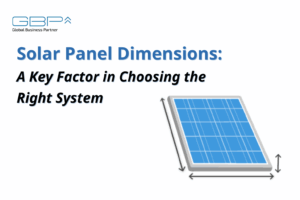Solar Panel Dimensions: A Key Factor in Choosing the Right System
01 Why Solar Panel Dimensions Matter
Solar panels are not “one-size-fits-all.” Their dimensions can influence:
System Design – Number of panels that can fit on a roof or mounting system
Energy Output – Larger panels typically offer higher wattage
Installation – Heavier or bigger panels may require additional structural support
Compatibility – Correct dimensions ensure smooth integration with inverters and mounting equipment
For example, according to the U.S. Department of Energy, panel size directly affects how much electricity a solar module can generate, making it essential to match dimensions with your energy goals.
02 Standard Solar Panel Dimensions
While panel size varies by brand and type, the industry generally follows these standards:
Residential Solar Panels
Residential panels are usually around 1.65 m x 1 m (65 in x 39 in), weighing 18–22 kg, with a typical wattage range of 250–400W. Their compact size makes them ideal for rooftops where space is limited.
Commercial Solar Panels
Commercial installations tend to use larger panels, averaging 2 m x 1 m (78 in x 39 in) and weighing 25–30 kg. These panels deliver higher wattages (400–600W) and are ideal for large-scale systems. As the Solar Energy Industries Association
notes, panel size and efficiency play a critical role in optimizing energy production for commercial use.
Portable / Specialty Panels
Portable panels are designed with smaller dimensions and lighter weights—often under 10 kg—for RVs, boats, or outdoor activities. While they produce less energy, their mobility makes them a favorite for off-grid lifestyles.
03 Solar Panel Dimensions and Energy Output
Generally, bigger panels = higher power output. For instance:
A 1.65 m residential panel may produce around 300W.
A 2 m commercial panel can exceed 500W.
However, as the International Energy Agency highlights, panel efficiency depends not just on size but also on materials and technology. Monocrystalline panels, for example, often outperform polycrystalline panels even at similar dimensions.
At GBP, we ensure that panel size and efficiency are balanced so our clients can maximize power generation without unnecessary space or weight issues.
04 How to Choose the Right Solar Panel Dimensions
When selecting the right panels for your project, consider:
Available Installation Area– Roof size, ground space, or structural limitations
Target Energy Output – How much electricity you want to generate
Budget – Larger panels may reduce the total number needed, lowering installation costs
System Design – Compatibility with inverters, transformers, and mounting structures
Future Maintenance – Consider long-term panel replacement needs
For example, our blog on solar panel replacement explains how panel lifespan and size can affect when and how replacements are carried out.
👉 Not sure which dimensions work best? Contact GBP today for expert consultation.
05 Conclusion
Solar panel dimensions are more than just numbers—they determine how effectively your solar system will perform. By choosing the right panel size for your needs, you can ensure greater efficiency, cost savings, and long-term reliability.
At GBP K.K., we continue to support global renewable energy adoption with products that meet both industry standards and customer-specific requirements. Whether you need compact residential panels or large-scale commercial solutions, our expertise guarantees the perfect fit.

